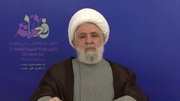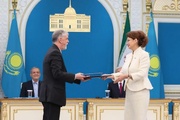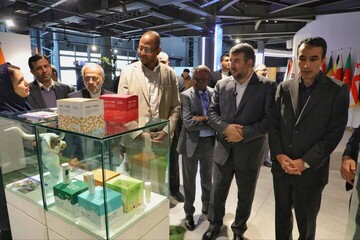-
 2025-12-14 22:01
2025-12-14 22:01
Attack on Jewish event in Bondi kills 11, injures dozens
Australia’s tragedy won’t wash Netanyahu’s bloody hands
TEHRAN – The massacre at Australia’s Bondi Beach on December 14 was a moment of unadulterated horror. As gunmen opened fire at the “Chanukah by the Sea” celebration, killing at least 11 and wounding dozens more, a community was left shattered.
-

By Sondoss Al Asaad
Hezbollah’s move in launching Women’s Action Unit marks a milestone
Forging resistance from the grassroots
BEIRUT—The official launch of Hezbollah’s Women’s Action Unit marks a defining organizational and social milestone, reflecting decades of accumulated women’s participation and responding to the demands of a critical historical moment.
-

By Shahrokh Saei
“Where’s Daddy?”: How Israel and US tech turn Gaza’s homes into graves
TEHRAN – Israel’s war in Gaza has been fueled not only by bombs and soldiers but by U.S. and European technology companies, whose services and access to Palestinian data have made mass killing possible.
-

‘Common perspective’ needed to protect ecological balance of Caspian Sea: Pezeshkian
TEHRAN – Iranian President Masoud Pezeshkian says to maintain the ecological balance of the Caspian Sea requires “a common perspective” by the regional countries.
-

By Afshin Majlesi
An inside look at Gorgan’s tribal festival
The 17th International Festival of Tribal Culture, scheduled to take place in Gorgan, the capital of Iran’s Golestan province, from Dec. 16 to 19, is often described as a celebration. But to see it only as a cultural event is to miss its deeper significance.
-

Culture ministers of Iran, Kazakhstan sign MoU on cinematic cooperation
TEHRAN – Iran’s Minister of Culture and Islamic Guidance Seyyed Abbas Salehi and the Minister of Culture and Information of Kazakhstan Aida Balayeva have signed a memorandum of understanding on cinematic cooperation in Astana, Kazakhstan.
Politics
-

What Iran’s foreign ministry spokesman said at his weekly briefing
TEHRAN – Iran’s Foreign Ministry on Monday addressed a broad range of regional and international developments, reaffirming its diplomatic positions on issues spanning regional conflicts, relations with neighboring countries, and disputes with the United States and its allies.
-

Israel’s misstep and the resilience of Iran’s strategic autonomy
MADRID – Few disclosures in West Asia carry as much weight as an admission of intelligence failure, particularly when it comes from an apparatus long celebrated for its carefully cultivated aura of omniscience.
-

Navy commander says readiness being boosted in line with emerging threats
TEHRAN – The commander of Iran’s Navy said the force is enhancing its readiness in proportion to evolving threats, citing the country’s growing scientific and technological capabilities in the maritime domain.
Sports
-

Fatemeh Sharif takes charge of Pakistan women’s futsal team
TEHRAN - The Pakistan Football Federation (PFF) on Sunday confirmed the appointment of Fatemeh Sharif Noghabi as the head coach of its national women’s futsal team.
-

Persepolis edge Aluminum at 2025/26 PGPL
TEHRAN – Persepolis football team edged past Aluminum 1-0 here on Sunday at the 2025/26 Iran’s Persian Gulf Professional League (PGPL).
-

Iran swimmer Gholami dreams of competing in Olympics
TEHRAN – Young Iranian swimming sensation Mohammadmahdi Gholami has revealed his ambition to compete at the Olympic Games.
Culture
-

Culture ministers of Iran, Kazakhstan sign MoU on cinematic cooperation
TEHRAN – Iran’s Minister of Culture and Islamic Guidance Seyyed Abbas Salehi and the Minister of Culture and Information of Kazakhstan Aida Balayeva have signed a memorandum of understanding on cinematic cooperation in Astana, Kazakhstan.
-

Iran, Tajikistan discuss ways to develop bilateral collaboration in publishing, printing industry
TEHRAN – A delegation of the printing and publishing sector of the Republic of Tajikistan, accompanied by Bahodur Nazir, counsellor at the Embassy of the Republic of Tajikistan to the Islamic Republic of Iran, visited the Ministry of Culture and Islamic Guidance in Tehran on December 13.
-

Iran cinema wins two awards at 16th Baku International Film Festival
TEHRAN – Iranian movies won two awards at the 16th Baku International Film Festival, which was held in Azerbaijan last week.
Economy
-

Cabinet approves general outline of next year’s budget bill
TEHRAN – Iran’s cabinet on Sunday approved the general framework of the government’s budget bill for the Iranian year 1405 starting late March 2026, during a meeting chaired by President Masoud Pezeshkian.
-

Oil Ministry targets completion of over 1,000 km of gas pipelines by late Mar. 2026
TEHRAN – Iranian Oil Ministry aims to complete and bring into operation more than 1,000 kilometers of gas transmission pipelines by the end of the current Iranian calendar year (late March 2026), Oil Minister Mohsen Paknejad said, underscoring efforts to strengthen energy security during periods of peak demand.
-

Iran, Pakistan push for joint trade committee, $10b trade target
TEHRAN – Iranian and Pakistani business representatives agreed to pursue the creation of a joint trade committee and work towards boosting bilateral trade to $10 billion, during a meeting in Karachi aimed at strengthening private-sector cooperation and facilitating cross-border commerce.
Society
-

Iran ready to foster tech ties, share expertise with Ethiopia
TEHRAN – The head of the Organization for the Development of International Cooperation in Science and Technology, Hossein Roozbeh, has announced the country’s readiness to share knowledge and boost technological cooperation with African countries, particularly Ethiopia.
-

Expo of creative, knowledge-based firms to focus on AI
TEHRAN – The fourth exhibition showcasing the achievements of creative and knowledge-based companies is scheduled to take place from December 28 to 31 in Tehran, with a focus on artificial intelligence (AI).
-

WFP releases November report on Iran
TEHRAN – The World Food Program (WFP) has released a report, expounding on activities in Iran over the month of November.
Tourism
-

An inside look at Gorgan’s tribal festival
The 17th International Festival of Tribal Culture, scheduled to take place in Gorgan, the capital of Iran’s Golestan province, from Dec. 16 to 19, is often described as a celebration. But to see it only as a cultural event is to miss its deeper significance.
-

Digi and glimpses of culinary heritage in Qaleh Bala village
TEHRAN – A traditional dish known as Digi, prepared using a centuries-old method in Iran’s Qaleh Bala village, offers insight into the area’s indigenous culinary culture, reflecting local knowledge, communal practices and social traditions passed down through generations.
-

How Carnet de Passage eases land travel in Iran
TEHRAN — The Touring and Automobile Club of the Islamic Republic of Iran (TACI) says the issuance of the Carnet de Passages en Douane (CPD) has created new opportunities for international land travel by simplifying border procedures for vehicles.
International
-

Australia’s tragedy won’t wash Netanyahu’s bloody hands
TEHRAN – The massacre at Australia’s Bondi Beach on December 14 was a moment of unadulterated horror. As gunmen opened fire at the “Chanukah by the Sea” celebration, killing at least 11 and wounding dozens more, a community was left shattered.
-

“Where’s Daddy?”: How Israel and US tech turn Gaza’s homes into graves
TEHRAN – Israel’s war in Gaza has been fueled not only by bombs and soldiers but by U.S. and European technology companies, whose services and access to Palestinian data have made mass killing possible.
-

Hezbollah’s move in launching Women’s Action Unit marks a milestone
BEIRUT—The official launch of Hezbollah’s Women’s Action Unit marks a defining organizational and social milestone, reflecting decades of accumulated women’s participation and responding to the demands of a critical historical moment.
Video Comment
-

Ayatollah Khamenei’s vision of freedom and humanity discussed in intl. conference
-

Iran hosts SCO joint anti-terror drills
-

Holy Mary Metro Station marks interfaith unity in Tehran
-

Academics analyze social dimensions of Resistance in Tehran conference
-

Culture minister highlights year of progress in arts, global image enhancement
Most Viewed
-
Australia’s tragedy won’t wash Netanyahu’s bloody hands
-
Who benefits from a disarmed Lebanon?
-
Afghanistan’s neighbors gather in Tehran to coordinate support for the war-torn country
-
Expert says Chinese investment in Iran difficult under sanctions, but possible with determination
-
Iran handed a favorable Group at 2026 World Cup, expert says
-
Caspian maritime consortium, ports expansion highlight Iran’s push for sea-based growth
-
Ethiopian parliament speaker says expanding bilateral ties with Iran a ‘priority’
-
Non-Iranian oil tanker smuggling fuel seized in Sea of Oman
-
Iran’s free zones attract $461m in foreign investment in 8 months
-
Nowruz-observing countries meet in New Delhi on safeguarding shared heritage
-
Israel exploiting Syrian instability to expand territorial control, Lebanese analyst warns
-
Eurovision: A measure of international sentiment against Israel
-
Iranian students shine at World Mathematics Team Championship 2025
-
What Iran’s foreign ministry spokesman said at his weekly briefing
-
Israel’s misstep and the resilience of Iran’s strategic autonomy







